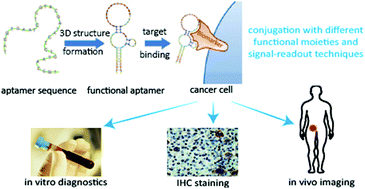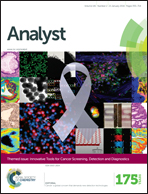Aptamers: versatile molecular recognition probes for cancer detection
Abstract
In the past two decades, aptamers have emerged as a novel class of molecular recognition probes comprising uniquely-folded short RNA or single-stranded DNA oligonucleotides that bind to their cognate targets with high specificity and affinity. Aptamers, often referred to as “chemical antibodies”, possess several highly desirable features for clinical use. They can be chemically synthesized and are easily conjugated to a wide range of reporters for different applications, and are able to rapidly penetrate tissues. These advantages significantly enhance their clinical applicability, and render them excellent alternatives to antibody-based probes in cancer diagnostics and therapeutics. Aptamer probes based on fluorescence, colorimetry, magnetism, electrochemistry, and in conjunction with nanomaterials (e.g., nanoparticles, quantum dots, single-walled carbon nanotubes, and magnetic nanoparticles) have provided novel ultrasensitive cancer diagnostic strategies and assays. Furthermore, promising aptamer targeted-multimodal tumor imaging probes have been recently developed in conjunction with fluorescence, positron emission tomography (PET), single-photon emission computed tomography (SPECT), and magnetic resonance imaging (MRI). The capabilities of the aptamer-based platforms described herein underscore the great potential they hold for the future of cancer detection. In this review, we highlight the most prominent recent developments in this rapidly advancing field.

- This article is part of the themed collection: Innovative Tools for Cancer Screening, Detection and Diagnostics

 Please wait while we load your content...
Please wait while we load your content...